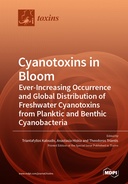Explore

Cyanotoxins in Bloom
0 Ungluers have
Faved this Work
Login to Fave
At present, cyanobacteria and their toxins (also known as cyanotoxins) constitute a major threat for freshwater resources worldwide. Cyanotoxin occurrence in water bodies around the globe is constantly increasing, whereas emerging, less studied or completely new variants and congeners of various chemical classes of cyanotoxins, as well as their degradation/transformation products are often detected. In addition to planctic cyanobacteria, benthic cyanobacteria, in many cases, appear to be important toxin producers, although far less studied and more difficult to manage and control. This Special Issue highlights novel research results on the structural diversity of cyanotoxins from planktic and benthic cyanobacteria, as well as on their expanding global geographical spread in freshwaters.
This book is included in DOAB.
Why read this book? Have your say.
You must be logged in to comment.
Rights Information
Are you the author or publisher of this work? If so, you can claim it as yours by registering as an Unglue.it rights holder.Downloads
This work has been downloaded 94 times via unglue.it ebook links.
- 94 - pdf (CC BY) at Unglue.it.
Keywords
- 16S rRNA phylogeny
- aeruginosamide
- aeruginosins
- allelopathy
- anabaenopeptin
- anabaenopeptins
- Analysis
- anatoxin
- anatoxin-a
- Azores
- benthic
- bioactive metabolites
- biocide
- blooms
- co-occurrence
- Cyanobacteria
- cyanobacterial metabolites
- cyanobacterial toxins
- cyanopeptides
- cyanotoxin detection
- cyanotoxins
- cyanotoxins (CTs)
- cylindrospermopsin
- deep-chlorophyll layers (DCLs)
- deoxycylindrospermopsin
- dereplication strategy
- detection methods
- dihydroanatoxin-a
- Earthquakes
- Economics
- Economics, finance, business & management
- Environmental economics
- ESI-LC-MS/MS
- Eutrophication
- fish tissue
- fragmentation spectra
- Georgian Bay
- global natural product social networking (GNPS)
- Greek freshwaters
- harmful algal blooms
- harmful bloom
- harmful cyanobacterial blooms
- HS-SPME-GC/MS
- hypoxia
- Lake Vegoritis
- LC-MS/MS
- LC–qTRAP MS/MS
- Liquid Chromatography with tandem mass spectrometry (LC-MS/MS)
- liquid chromatography-tandem mass spectrometry
- long term monitoring
- macrophytes
- Mass Spectrometry
- Maumee Bay
- Meiktila Lake
- Metals
- microcystin
- microcystins
- microcystins (MCs)
- Microcystis
- microginins
- Monitoring
- n/a
- neurotoxicosis
- next-generation biomonitoring
- NRPS
- peptide
- planktonic cyanobacteria
- Planktothrix
- Plastics
- qPCR
- Raphidiopsis
- real-time PCR
- Reference, information & interdisciplinary subjects
- Research & information: general
- reservoir
- Sandusky Bay
- saxitoxin
- sediment
- sediment cores
- Shellfish
- SPE
- SPE-LC-MS/MS
- structure elucidation
- Synechococcus
- taste and odor (T&O) compounds
- temperate lakes
- Toxicity
- Tychonema
- tychoplanktic
- volatile organic compounds (VOCs)
- Water quality
Links
DOI: 10.3390/books978-3-0365-3921-8Editions

